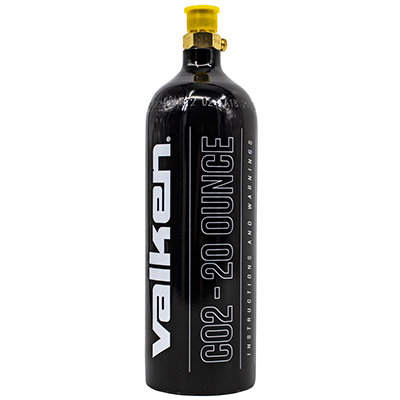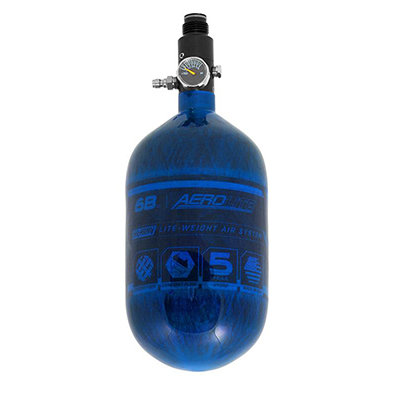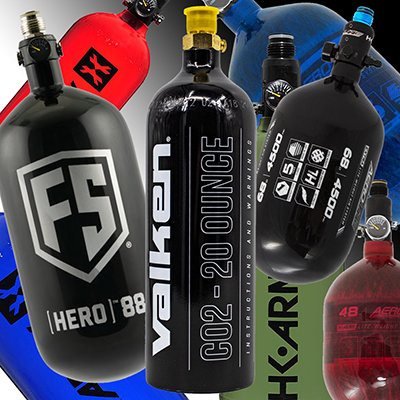Paintball Air Tank Buyer's Guide
Posted by Josh Silverman on 11th Dec 2020
Paintball Air Tank Buyer's Guide
When it's time to pick a paintball air tank, there are many choices and selecting the right paintball air bottle out of the pile can be a daunting decision! Which air tank is right for you? Let Valken help you select the best paintball air tank for your paintball gun so you can enjoy the best performance from your paintball gun and focus on winning the game!
Paintball CO2
Paintball guns have been powered by CO2 since literally the first game of paintball ever played, in the woods of New Hampshire in 1981! Those simple bolt-action paintball marking pistols were powered by 12gram CO2 cartridges and those same 12gram cartridges are still in use today in paintball guns like paintball pistols! However, they’re not the only source of air power paintball guns use today, nor are they even the only way CO2-powered paintball guns get their air! Paintball CO2 cartridges were joined in the late 80’s and early 90’s by paintball air tanks and paintball CO2 bottles, a setup called constant air, that used various size CO2 tanks to allow a player to play an entire game of paintball without stopping to swap out a depleted CO2 cartridge for a full one! These paintball CO2 tanks have endured to the modern day thanks to their combination of affordability and their ability to provide hundreds of low-cost shots to paintball guns compatible with CO2, generally entry-to-mid-level paintball guns like the Valken Blackhawk, Tippmann 98 Custom, Spyder series and the GOG eNMEy paintball gun!
The most common paintball CO2 tank available currently is the 20oz paintball CO2 tank. Long the backbone of serious paintball players, the 20oz Co2 tank remains an affordable and solid choice for players using paintball guns able to use CO2 as a propellant source. Players starting their paintball adventure, or playing with friends with blowback-style paintball guns can expect to enjoy hundreds of full-power shots from a 20oz CO2 tank in warm weather, but this will also depend on how fast a player shoots and at what velocity, and the ambient temperature as CO2 is susceptible to pressure changes based on temperature, rate of fire and other factors. Paintball guns like the Valken Blackhawk, Tippmann 98 Custom or the Tippmann Cronus and the GOG eNMEy are best-able to handle CO2 as their propellant source while remaining consistent.
Paintball air tanks and CO2 cartridges, susceptible to temperature and pressure changes as they are, are safe when used and stored properly. As such, paintball players should always take care to store their paintball CO2 tank indoors, at room temperature and out of direct sunlight. While these tanks will not rupture or otherwise fail spectacularly, as they are equipped with pressure burst disks that will vent pressure should they over-pressurize for any reason, this is never a fun thing to happen by surprise if a tank is left in the trunk of a hot car during the summer or by a heat source in the house.
Compressed Air
By the early-to-mid-nineties, serious paintball players were able to shoot faster than ever and CO2 had its hands full keeping up. Players and the industry were looking for an alternative, and it was found in paintball compressed air! Compressed air for paintball purposes is often also called nitrogen, or HPA (high pressure air) and is delivered to paintball guns from compressed air tanks and paintball compressed air bottles that are built to hold air pressurized to between 3000 and 4500psi. These are bottles are also equipped with regulators that lower this pressure to 800psi or lower, the pressure at which most paintball guns operate. While paintball compressed air tanks are generally more expensive than CO2 tanks, compressed air, when used for paintball, offers a cleaner air source that is not susceptible to air temperature issues and can stand up to fast firing without pressure drop-offs. Modern paintball compressed air tanks are threaded at the regulator, allowing them to thread into practically any paintball gun’s air bottle adapter or ASA (air source adapter).
Entry-level paintball compressed air systems generally cost approximately $50 and these are, most often, a 3000psi system with a 48 cubic inch capacity bottle. On most paintball guns, these bottles when filled will deliver a few hundred shots. Stepping up from basic paintball compressed air tanks to higher-end paintball HPA bottles will see the buyer able to select between various air tank sizes that will allow for more shots, and move up to 4,500psi air bottles that, again, provide a higher number of shots without having to massively increase the size of the bottle. These air systems are also often available with adjustable regulators, allowing the user to fine-tune their compressed air bottle to their paintball gun for optimum performance! Paintball compressed air bottles like these are generally available in 45, 48, 68, 77, 88 and 90 cubic inch sizes and sometimes even bigger, as companies like First Strike even offers 100 and 124 cubic inch compressed air bottles, allowing the user to select the air system that will provide the best mix of shots per fill, light weight and bottle length that’s comfortable for the player to carry around all day! While much more expensive than basic air systems at around $200 or more, these paintball air tanks will last for years if treated properly, and can be used with practically any paintball gun from entry-level models to high-end, professional-grade electronic paintball guns!
Players looking to make a decision on which paintball compressed air bottle is right for them have many factors to consider as compared to those utilizing CO2 as their paintball air source. For paintball players who need 12gram CO2 cartridges, whatever is on the shelf is generally what will be used, though Umarex does advertise that their air is much cleaner than many competitors. For players using CO2, the best choice is a 20oz CO2 tank as this is the best combination of consistency, size and shots per tank available, though other sizes like 9oz CO2 tanks and 12oz paintball CO2 tanks are still available. That said, players looking for a paintball compressed air tank often start with price, and the 48/3000 paintball compressed air tank is by far the least expensive, and available from various manufacturers like Valken, Ninja, HK Army and several other brands. Younger and smaller players, or those who are fast and tasked with charging well up the field during games of paintball, may wish to consider a smaller, lighter bottle that will still provide plenty of shots per fill, like 45 cubic inch or 48 cubic inch, 4500psi air systems. Players who like to shoot fast, and shoot pod after pod of paintballs per game, either because they have to or because they like to, should consider a much larger tank, like a 77, 88, 90 cubic inch tank or larger, as these will provide the air capacity necessary to shoot between 1000 and 1500 paintballs per fill. As a general rule, the middle-ground paintball HPA tanks that will provide plenty of shots without being too expensive or too heavy land in the 68 cubic inch, 4,500psi range, with price then varying depending on the style of regulator the buyer might choose.
Making a good choice on both the source, and size of the source, of air used to power a paintball gun is a critical decision that will help ensure a great day of play for any paintball player. A great, high-dollar paintball gun won’t be able to run at it’s best with a substandard air source, while even a cheap paintball gun will shoot better with a high-quality paintball air tank used to power it!



